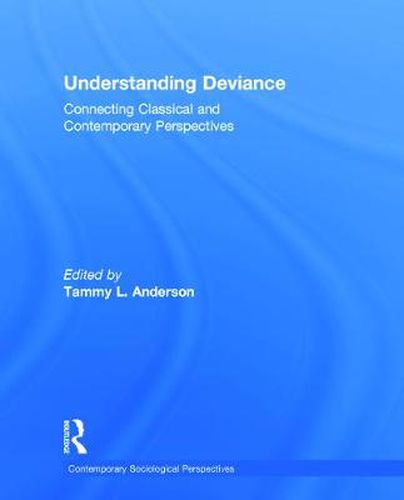Readings Newsletter
Become a Readings Member to make your shopping experience even easier.
Sign in or sign up for free!
You’re not far away from qualifying for FREE standard shipping within Australia
You’ve qualified for FREE standard shipping within Australia
The cart is loading…






In this collection of 48 reprinted and completely original articles, Tammy Anderson gives her fellow instructors of undergraduate deviance a refreshing way to energize and revitalize their courses. [36 are reprints; 12 are original to this text/anthology]
First, in 12 separate sections, she presents a wide range of deviant behaviors, traits, and conditions including: underage drinking and drunk driving, doping in elite sports, gang behavior, community crime, juvenile delinquency, hate crime, prison violence and transgendered prisoners, mental illness, drug-using women and domestic violence, obesity, tattooing, sexual fetishes, prostitution, drug epidemics, viral pandemics, crime control strategies and racial inequality, gay neighborhoods, HIV and bugchasers, and (lastly) youth, multicultural identity and music scenes.
Second, her pairing of classic and contemporary viewpoints about deviance and social control not only connects important literatures of the past to today’s (student) readers, her connections framework also helps all of us see social life and social processes more clearly when alternative meanings are accorded to similar forms of deviant behavior. We also learn how to appreciate and interact with those who see things differently from ourselves. This may better equip us to reach common goals in an increasingly diverse and ever-changing world.
Third, a major teaching goal of Anderson’s anthology is to sharpen students’ critical thinking skills by forcing them to look at how a deviant behavior, trait or condition, can be viewed from opposing or alternative perspectives. By learning to see deviance from multiple perspectives, students will better understand their own and other’s behavior and experiences and be able to anticipate future trends. Balancing multiple perspectives may also assist students in their practical work in social service, criminal justice and other agencies and institutions that deal with populations considered deviant in one way or another.
$9.00 standard shipping within Australia
FREE standard shipping within Australia for orders over $100.00
Express & International shipping calculated at checkout
In this collection of 48 reprinted and completely original articles, Tammy Anderson gives her fellow instructors of undergraduate deviance a refreshing way to energize and revitalize their courses. [36 are reprints; 12 are original to this text/anthology]
First, in 12 separate sections, she presents a wide range of deviant behaviors, traits, and conditions including: underage drinking and drunk driving, doping in elite sports, gang behavior, community crime, juvenile delinquency, hate crime, prison violence and transgendered prisoners, mental illness, drug-using women and domestic violence, obesity, tattooing, sexual fetishes, prostitution, drug epidemics, viral pandemics, crime control strategies and racial inequality, gay neighborhoods, HIV and bugchasers, and (lastly) youth, multicultural identity and music scenes.
Second, her pairing of classic and contemporary viewpoints about deviance and social control not only connects important literatures of the past to today’s (student) readers, her connections framework also helps all of us see social life and social processes more clearly when alternative meanings are accorded to similar forms of deviant behavior. We also learn how to appreciate and interact with those who see things differently from ourselves. This may better equip us to reach common goals in an increasingly diverse and ever-changing world.
Third, a major teaching goal of Anderson’s anthology is to sharpen students’ critical thinking skills by forcing them to look at how a deviant behavior, trait or condition, can be viewed from opposing or alternative perspectives. By learning to see deviance from multiple perspectives, students will better understand their own and other’s behavior and experiences and be able to anticipate future trends. Balancing multiple perspectives may also assist students in their practical work in social service, criminal justice and other agencies and institutions that deal with populations considered deviant in one way or another.